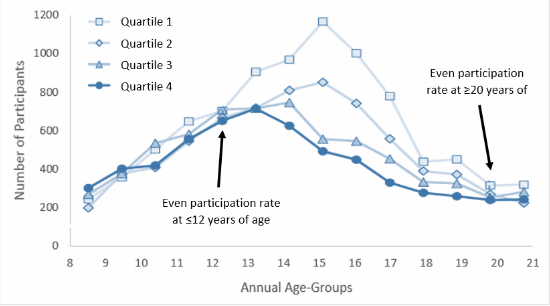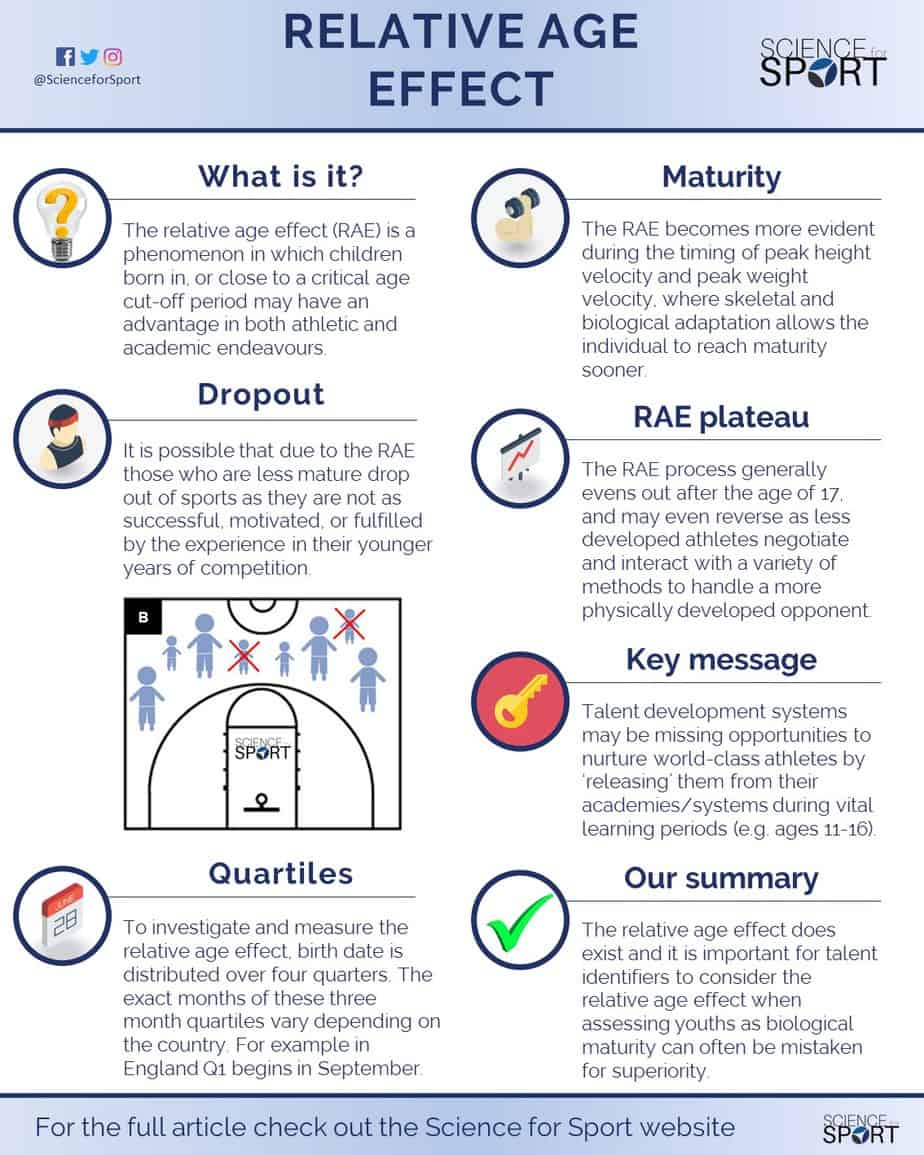Contents of Article
- Summary
- Can birth timing impact talent identification?
- What is the relative age effect?
- How should the relative age effect influence training?
- Is future research needed with the relative age effect?
- Conclusion
- References
- About the Author
Summary
The common practice of placing children into age groups for sport may acutely benefit those who are more developed physically, emotionally, and cognitively (1). However, those who are born in the later stages of the year appear to experience an unintentional bias in their long-term sporting success (1).
In accordance with this, it is important that coaches are aware of a ‘Relative Age Effect’, where being born at a certain time of the year holds a distinct advantage in sport and academic success. In other words, those born later in the year appear to be at a disadvantage because they are typically physically, emotionally and cognitively less developed than other children.

Can birth timing impact talent identification?
The assessment of physical abilities in talent identification, particularly in team sports, is common practice in professional sport (2). Talent identification may be influenced by many physical attributes and bio-motor abilities; such as speed, power, strength, and aerobic capacity (3).
However, it has also been suggested that birth timing plays an important role in talent identification and selection. In fact, this was demonstrated recently in the seventh International Children’s Winter Games 2016 when older children appeared to have a 3.5 times greater chance of being selected than younger athletes (4). The effect that birth timing and selection has on talent identification is simply known as the ‘relative age effect’.
What is the relative age effect?
The relative age effect is a phenomenon in which children born in, or close to, a critical age cut-off period may have an advantage in both athletic and academic endeavours (5). An earlier birth is typically associated with increased physical ability. This was shown in a recent study (3), where more mature soccer players were faster than their ‘less mature’ peers due to a biological advantage. As a result, it appears that the relative age effect (i.e. being born later potentially puts you at a disadvantage) is principally due to being physically, emotionally and cognitively less developed than other children.
In addition, individuals born in the early quartiles are more likely to persevere in sport, by being able to actively dominate in physical bouts and key performance measures. This suggests that as time goes on, those who are less mature drop out of sports as they are not as successful, motivated, or fulfilled by the experience in their younger years of competition (5) (See Figure 1).

Birth timing and athletic advantage
To investigate and measure the relative age effect, birth date is distributed over four quarters (6). In England, these are:
Quartile 1 – Athletes born in September – November
Quartile 2 – December – February
Quartile 3 – March – May
Quartile 4 – June – August
NOTE: Although they are always segregated into four quarters, these months may vary based on the country and their sport and academic selection years.
Youth athletes born in quartiles 1 and 2 generally have a distinct advantage over their later-born peers. This becomes more evident during the timing of Peak Height Velocity and Peak Weight Velocity in males and females, where skeletal and biological adaptation allows the individual to reach maturity sooner, where enhanced morphology (muscle size, strength and aerobic capacity) increases the likelihood of selection (6). This has recently been shown in a local community rugby team, where those who were born in the earlier quartiles were still participating in their sport through the typical onset of maturation compared to those born in the later quartiles (See Figure 2). Figure 2 demonstrates that whilst participation numbers remain balanced prior to the onset of maturation, there is also a sudden dropout rate in younger athletes (those born in quartiles 3 and 4) once the onset of maturation is reached (at approximately 13 years of age).

How should the relative age effect influence training?
Fortunately for athletes, this process generally evens out after the age of 17 (6), and may even reverse as less developed athletes negotiate and interact with a variety of methods to handle a more physically developed opponent (7). However, talent identification development systems may be missing opportunities to nurture world-class athletes by ‘releasing’ them from their academies/systems during vital learning periods (e.g. 11-16 years of age).
Whilst this article has presented some of the benefits of being born in early quartiles (1 to 2), some studies have shown that this can lead to early sport specialisation (i.e. focussing solely on one sport), and overuse injuries in later years (5, 6), which should be regulated and monitored by a qualified practitioner.
Is future research needed with the relative age effect?
Future research should look to investigate the prevalence of a relative age effect in youth sport, with the aim to address:
- How can coaches constrain an environment to support those born in the early and late quartiles?
- How does relative age effect affect retention rates in sport?
- What other methods can be used to create developmental playing and exercise experience?
Conclusion
Whilst it is evident that a relative age effect does exist, it is difficult to quantify how this impacts an athlete’s holistic development throughout their youth experiences. This is increasingly challenging, as children born on the 28th August and 1st of September (three days’ difference) can be separated by an entire academic school year, at least in England. It is, therefore, important the relative age effect is considered when selecting and identifying talent in both athletic and academic environments in order to account for any under- and/or over-performances.
Put simply, it is important for talent identifiers to consider the relative age effect when assessing youths as biological maturity can often be mistaken for superiority.
- Mann, D.L. and van Ginneken, P.J., 2017. Age-ordered shirt numbering reduces the selection bias associated with the relative age effect.Journal of sports sciences, 35(8), pp.784-790. https://www.ncbi.nlm.nih.gov/pubmed/27238077
- Cripps, A.J., Joyce, C., Woods, C.T. and Hopper, L.S., 2017. Biological maturity and the anthropometric, physical and technical assessment of talent identified U16 Australian footballers.International Journal of Sports Science & Coaching, 12(3), pp.344-350. https://researchonline.jcu.edu.au/49276/
- McCunn, R., Weston, M., Hill, J.K., Johnston, R.D. and Gibson, N.V., 2017. Influence of physical maturity status on sprinting speed among youth soccer players.The Journal of Strength & Conditioning Research, 31(7), pp.1795-1801. http://journals.lww.com/nsca-jscr/Citation/2017/07000/Influence_of_Physical_Maturity_Status_on_Sprinting.6.aspx
- Müller L, Hildebrandt C and Raschner C. The Role of a Relative Age Effect in the 7th International Children’s Winter Games 2016 and the Influence of Biological Maturity Status on Selection. Journal of Sports Science and Medicine (2017) 16, 195-202. https://www.ncbi.nlm.nih.gov/pmc/articles/PMC5465981/
- Stracciolini, A., Friedman, H.L., Casciano, R., Howell, D., Sugimoto, D. and Micheli, L.J., 2016. The relative age effect on youth sports injuries.Medicine & Science in Sports & Exercise, 48(6), pp.1068-1074. https://www.ncbi.nlm.nih.gov/pubmed/26765629
- Cobley, S.P. and Till, K., 2017. Participation trends according to relative age across youth UK Rugby League.International Journal of Sports Science & Coaching, p.1747954117710506. http://journals.sagepub.com/doi/abs/10.1177/1747954117710506
- Cumming, S.P., Lloyd, R.S., Oliver, J.L., Eisenmann, J.C. and Malina, R.M., 2017. Bio-banding in sport: applications to competition, talent identification, and strength and conditioning of youth athletes. Strength & Conditioning Journal, 39(2), pp.34-47. http://journals.lww.com/nsca-scj/Abstract/2017/04000/Bio_banding_in_Sport___Applications_to.6.aspx





